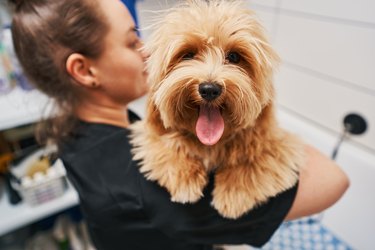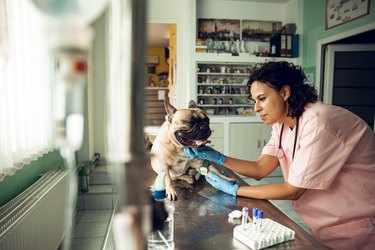Any injury to your dog that calls for an antiseptic is also worthy of a call your veterinarian. Punctures, animal bites, or other serious wounds need professional medical attention. But your vet might give you the green light to treat less serious wounds at home or have you clean them before you get to the clinic.

Video of the Day
Some antiseptics such as dog wound spray, serve as disinfectants and are good cleaning agents to use around your dog. Don't pull out an antiseptic intended only for humans without your veterinarian's approval; you can find a pet safe antiseptic at your local pharmacy, making them easy to keep on hand for those unexpected canine catastrophes.
Video of the Day
Common antiseptic for dogs
Chlorhexidine and povidone iodine represent two of the most common antiseptics for dogs and are easy to obtain. Chlorhexidine works on several microorganisms, including gram negative and gram positive bacteria. Many dog products contain chlorhexidine, including shampoos and ear rinses. Povidone iodine is commonly used by veterinarians as a surgical disinfectant before and after surgery, because it destroys viruses, bacteria, and fungi.
While you might have hydrogen peroxide in your medicine cabinet, don't use it unless it's all you have or you have your veterinarian's permission. Hydrogen peroxide is only minimally effective as an antiseptic. It can also damage tissues and is not a pet safe antiseptic. Sometimes cleaning with water or saline solution is the best approach.
How to use a topical canine antiseptic

Whether you are using Chlorhexidine or povidone iodine, don't use either full strength. For instance, before using chlorhexidine, dilute it with water until it is light blue. Similarly, if you are using povidone iodine, diluted it until it is the color of weak tea. Clean around a wound, but not directly in it, unless instructed by your veterinarian.
Flush the wound with plain tap water, using only enough force to remove dirt and debris from the damaged area. A syringe provides a good low-pressure choice for this cleaning. Your vet might recommend adding salt or Epsom salts to flush the wound.
Other dog antiseptics and uses
Don't be quick to reach for the isopropyl alcohol —rubbing alcohol — for treating your dog. While an effective antiseptic, it can burn when applied topically and can cause toxicity if he licks the area, as well as irritate his respiratory tract. However, you can use it to clean a dog's living quarters, such as a crate or kennel at a boarding facility, when disinfecting is necessary. Potassium peroxymonosulfate, sold under the brand name Trifectant, is another effective disinfectant that animal shelters use for cleaning.
Difference between antiseptics and antibiotics

Antiseptics destroy microorganisms indiscriminately and also prevent them from growing. Conversely, when your vet discerns that an antibiotic is warranted, she recommends it based on the type of infection present. For example, a fungal infection won't respond well to an antibiotic designed to target a specific bacterial infection. Keep in mind that sweeping use of antibiotics — even topical ones — can also lead to increased resistance against them, making certain infections hard to treat.